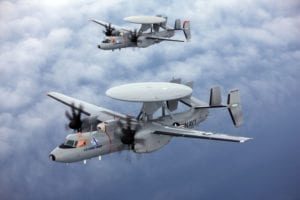The Navy’s fiscal year 2023 $4 billion unfunded priorities list focuses on adding more missiles, aircraft and spare parts rather than additional ships, according to documents.
The service’s top priority is funding industrial operations at $23 million to more quickly convert the remaining 125 early Standard Missile (SM)-6 Block I Non-Combat Usable Asset (NCUA) inventory into combat-ready weapons. The documents noted the SM-6 production line is at maximum capacity across all variants at 125 missiles per year over FY ‘23-’24 and is expected to ramp up to 200 missiles per year for FY ‘26 and then 300 missiles per year by FY ‘28.
The second priority is $33 million for 11 more Long Range Anti-Ship missiles (LRASM) beyond the requested 60 missiles. The Navy’s documents said this would “achieve industry’s maximum production capacity in FY23 for next-generation Offensive Anti-Surface Warfare (OASuW) Increment 1.”
The next top priorities are $171.4 million in maritime spares outfitting for surface, subsurface, unmanned and cyber/information technology systems to finish the remaining spares account shortfalls in FY ‘23 and buy down future risk; $175 million in organizational level ship maintenance and repair parts and funding temporary additional duty for Pacific Deterrence Initiative fleet training and exercises; and $293 million in aviation outfitting spares in support of carrier air wing shipboard allowances.
The highest value item on the list, at number 10, is $708 million to increase F-35C Joint Strike Fighter Low-Rate Initial Production (LRIP) Lot-17 procurement by six aircraft, from nine to 15 total. The Navy document said adding these aircraft would provide capacity not currently in the fleet like additional weapons and an 8,000-flight hour airframe.
During a roundtable ahead of the budget release on March 28, Rear Adm. John Gumbleton, Deputy Assistant Secretary of the Navy for Budget, said the Navy lowered its planned of 15 F-35Cs to nine in FY ‘23 as a way to balance budgetary pressure and priorities, rather than due to the cost of the aircraft itself (Defense Daily, March 28).
“So it was about balancing ship construction with aviation, weapons, R&D etc. So we would have liked to add more JSF, but that’s the balance that we could yield,” Gumbleton said.
The Navy unfunded priorities list also includes $446 million to start replacing the legacy C/KC-130T aircraft with three KC-130J aircraft for intra-theater transport. The Navy’s document noted the C-130 Hercules is the Navy’s only intra-theater aerial logistics platform able to include oversized cargo like all F-35 engine modules and CMV-22 detachments.

Down at number 19, the service listed $400 million to add two more E-2D Advanced Hawkeye aircraft from the base request of five, increasing the total request to seven aircraft.
The document said while the Navy’s requirement is for 86 total E-2Ds, the current multi-year contract finishes the program with 78 delivered aircraft. FY ‘23 is slated to be the last year of procurement, with the line shutdown starting in FY ‘24. Adding two more E-2Ds “maximizes industrial capacity and will increase readiness, aircraft survivability and reduce operational risk,” bringing the fleet to eight aircraft total, the Navy’s unfunded list document said.
The service asked for $26 million to procure 79 more AIM-9X Sidewinder short-range self-defense air-to-air missiles used by F/A-18s and F-35s. The Navy argued this aims to “to maintain steady demand signal to industry and close this critical capacity gap.”
The Navy also requests $49 million to increase the MK 48 heavyweight torpedo procurement from 28 to 50 “to achieve stepladder pricing efficiencies.”
The Navy said these munitions are needed to increase inventory to address the increased Navy/Office of the Secretary of Defense Munitions Requirement process (MRP) requirements gap and supply adequate submarines to combatant commander plans.
“The MK 48 production line is starting to deliver new torpedoes in FY22, and the existing FY23 procurement profile combined with recent unit cost increases, has dropped procurement levels to a challenging return on investment price point of 28 procurements,” the list said.
The Navy is also requesting $67 million in two Next Generation Jammer Mid-Band shipsets that would be delivered and deployed as four pods in FY ‘25. The Navy argued that “additional shipset procurement maximizes production line capability resulting in lower per-unit pod cost,” for these new electronic warfare systems.
The service is requesting $45 million to complete the refueling and complex overhaul (RCOH) of the USS George Washington (CVN-73), whose delivery was extended from December 2022 to March 2023. The document said this funds $25 million in re-delivery cost and $20 million in time related services. “This is in addition to the $62M cost-to-complete funded in PB23 request based on updated re-delivery date shift after PB23 submission,” the list said.
Notably, the list also requests $11.2 million to enable Littoral Combat Ships (LCS) to launch and recover a fully-fueled ordnance-loaded Mine Countermeasures Unmanned Surface Vessel (MCM USV) from the Twin-Boom Extensible Crane through Sea State 4 conditions.
“Funding provides: study confirming structural reinforcement and safety margins required for OP-4 weapons handling onboard LCS for launch of MCM USV with Barracuda neutralizers and capacity to launch MCM USV with additional fuel-extending MCM mission times; storage of Barracuda onboard LCS; and provides software updates with capability for human-in-the loop to command mine neutralization,” the list said.